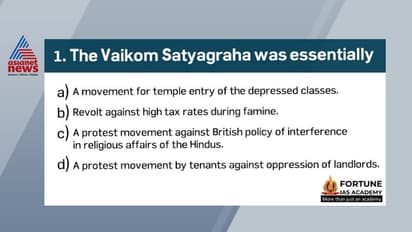സിവില് സര്വ്വീസ് പരീക്ഷ; ബുദ്ധമത പാരമ്പര്യപ്രകാരം ലോക രക്ഷാര്ത്ഥം ഇനി അവതരിക്കാനിരിക്കുന്ന ബുദ്ധന് ആര് ?
ഇന്ത്യന് ബ്യൂറോക്രസിയുടെ ഏറ്റവും ഉയര്ന്ന പദവിയിലേക്കുള്ള പരീക്ഷയാണ് സിവില് സര്വ്വീസ് പരീക്ഷ. ഇന്ത്യന് അഡ്മിനിസ്ട്രേറ്റീവ് സര്വ്വീസ് (ഐഎഎസ്), ഇന്ത്യന് പൊലീസ് സര്വ്വീസ് (ഐപിഎസ്), ഇന്ത്യന് ഫോറിന് സര്വ്വീസ് (ഐഎഫ്എസ്) എന്നീ ഗ്ലാമര് പദവികള് മുതല് നിരവധി വകുപ്പുകളിലേ ക്ലാസ് വണ് ഉദ്യോഗങ്ങളിലേക്കും ചില ഗ്രൂപ്പ് ബി തസ്തികകളിലേക്കുമുള്ള തെരഞ്ഞെടുപ്പും സിവില് സര്വ്വീസ് പരീക്ഷയെ അടിസ്ഥാനമാക്കിയാണ് നടക്കുന്നത്. അതുകൊണ്ട് തന്നെ കടുത്ത മത്സരം നടക്കുന്ന പരീക്ഷകളിലൊന്നാണ് സിവില് സര്വ്വീസ് പരീക്ഷ. പരീക്ഷയ്ക്കിറങ്ങും മുമ്പ് നിരന്തരമുള്ള തയ്യാറെടുപ്പ് ആവശ്യമാണ്. ഫോര്ച്ച്യൂണ് അക്കാദമിയും ഏഷ്യാനെറ്റ് ഓണ്ലൈനും ചേര്ന്നൊരുക്കുന്ന സിവില് സര്വ്വീസ് പരീക്ഷാ ചോദ്യോത്തരങ്ങളുടെ പതിനൊന്നാമത്തെ ചോദ്യാവലിയാണിത്. സിവില് സര്വ്വീസില് മാത്രമല്ല, കേരള സിവില് സര്വ്വീസ് പരീക്ഷയെന്നറിയപ്പെടുന്ന കേരള അഡ്മിനിസ്ട്രേറ്റ് സര്വ്വീസ് (KAS) പരീക്ഷയ്ക്കുള്ള പഠനത്തിനും ഈ ചോദ്യോത്തരങ്ങള് നിങ്ങളെ സഹായിക്കും. അതെ, ചെറിയ ചില കാല്വെപ്പുകള് വിലയ മുന്നേറ്റങ്ങള്ക്ക് കാരണമാകാം. വരൂ, നമ്മുക്കൊന്നിച്ച് മുന്നേറാം.

Answer: (a)
Statement a is CORRECT:
Vaikom Satyagraha
Source: India’s struggle for Independence, Bipan Chandra, chapter 18.
Answer: (a)
Statement a is CORRECT:
Vaikom Satyagraha
Source: India’s struggle for Independence, Bipan Chandra, chapter 18.
Answer: (b)
Sanyasi Rebellion
Source: Modern Indian History, Sonali Bansal & Snehil Tripathi, chapter 4
Answer: (b)
Sanyasi Rebellion
Source: Modern Indian History, Sonali Bansal & Snehil Tripathi, chapter 4
Answer: (c)
Answer: (c)
Answer : (c)
The Lotus Temple also known as the Bahai House of Worship or Bahai Mashriqul-Adhkar Temple is one of the best architectural marvels in the country in modern times. The white marble structure is also called the Taj Mahal of the 20th century but it is so much more than just a splendid piece of architecture. It is a place where several visitors from all across the globe come for peace, meditation, prayers and study.
Answer : (c)
The Lotus Temple also known as the Bahai House of Worship or Bahai Mashriqul-Adhkar Temple is one of the best architectural marvels in the country in modern times. The white marble structure is also called the Taj Mahal of the 20th century but it is so much more than just a splendid piece of architecture. It is a place where several visitors from all across the globe come for peace, meditation, prayers and study.
Answer: (d)
Answer: (d)
Answer: (d)
Source:https://rsis.ramsar.org/sites/default/files/rsiswp_search/exports/Ramsar-Sites- annotated-summary-India.pdf?1588747705
Answer: (d)
Source:https://rsis.ramsar.org/sites/default/files/rsiswp_search/exports/Ramsar-Sites- annotated-summary-India.pdf?1588747705
Answer: (a)
Source: https://www.khanacademy.org/science/biology/biotech-dna- technology/dna-cloning-tutorial/a/restriction-enzymes-dna-ligase
Answer: (a)
Source: https://www.khanacademy.org/science/biology/biotech-dna- technology/dna-cloning-tutorial/a/restriction-enzymes-dna-ligase
Answer: (c)
Mahe is the smallest district in India. It has an area of 9 sq. km. Mahe is geographically located in the state of Kerala, where as administratively it comes under the control of Union Territory of Pondicherry. Mahe has the official name of Mayyazhi in the local Malayalam language. Mahe has a population of about 36,000 according to the 2001 census. The population density of the town is 4091 per sq. km. Males constitute 47% of the population and females 53%. Mahe has an average literacy rate of 85%. Mahe has two members in the Pondicherry Legislative Assembly, representing Mahe and Palloor.
Source: https://censusindia.gov.in/census_data_2001/india_at_glance/area.aspx
Answer: (c)
Mahe is the smallest district in India. It has an area of 9 sq. km. Mahe is geographically located in the state of Kerala, where as administratively it comes under the control of Union Territory of Pondicherry. Mahe has the official name of Mayyazhi in the local Malayalam language. Mahe has a population of about 36,000 according to the 2001 census. The population density of the town is 4091 per sq. km. Males constitute 47% of the population and females 53%. Mahe has an average literacy rate of 85%. Mahe has two members in the Pondicherry Legislative Assembly, representing Mahe and Palloor.
Source: https://censusindia.gov.in/census_data_2001/india_at_glance/area.aspx
Answer: (c)
The Scheme consists of three components:
Source: https://pib.gov.in/PressReleaseIframePage.aspx?PRID=1565274
Answer: (c)
The Scheme consists of three components:
Source: https://pib.gov.in/PressReleaseIframePage.aspx?PRID=1565274
Answer: (d)
Answer: (d)